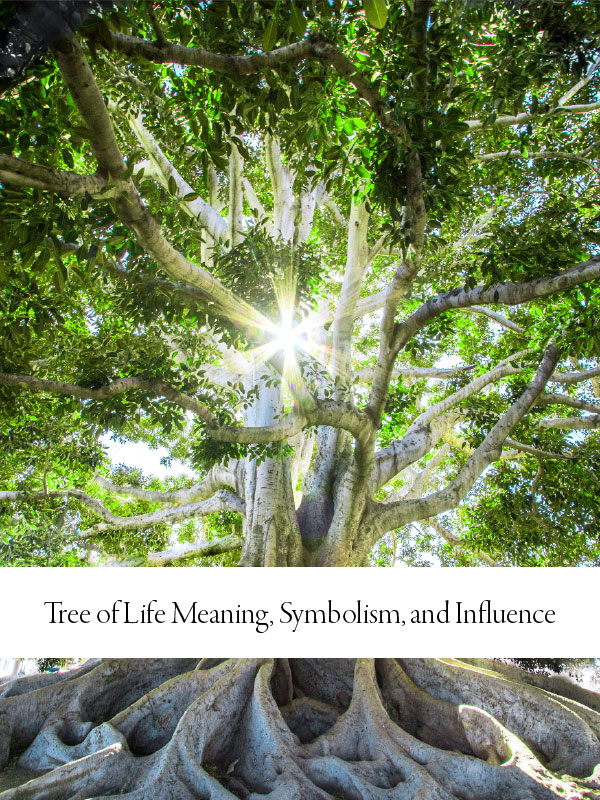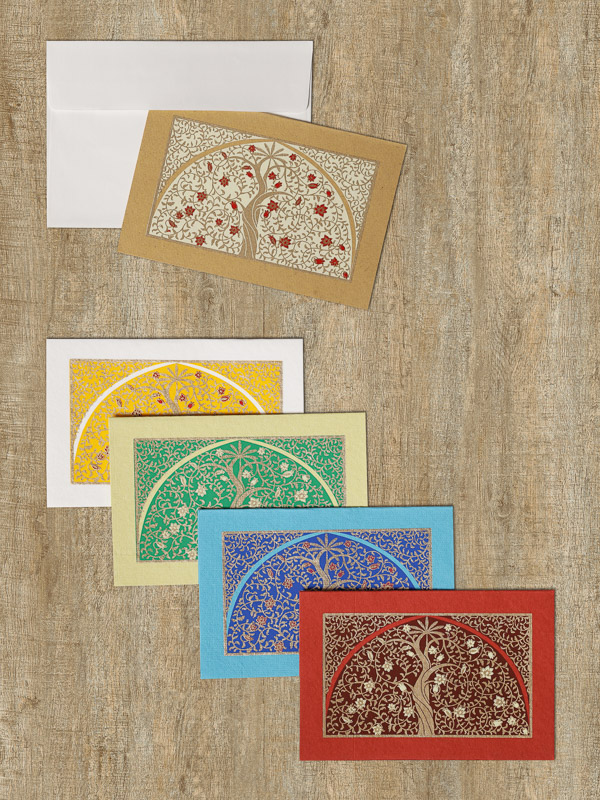The tree of life meaning includes enlightenment, wisdom, resilience, longevity, spiritual growth, and connectivity. Various cultures and peoples, from Vikings to the Chinese, have long incorporated the tree of life symbolism into their religions, art, and culture. Discover what does the tree of life mean in this guide where we review everything from the tree of life spiritual meaning to its influence in art.

Table of contents:
- All about the tree of life
- Tree of life symbolism by culture
- Kabbalah tree of life
- Celtic tree of life
- Chakra tree of life
- Viking/Nordic tree of life
- Chinese mythology
- Hindu tree of life
- Tree of life spiritual meaning
- Tree of life inspiration for art
- Decorating with tree of life symbolism
All about the tree of life
The tree of life symbol is found in various cultures around the world, depicted in myths, philosophies, folklore, and religions. Depicted as a mighty tree with a developed root system and a thriving crown, the tree of life takes on new meaning between cultures. This ancient symbol is revered as a representation of the connection between the physical world and the spiritual world, celestial powers, and rebirth.
Tree of life symbolism by culture
What does the tree of life mean in different cultures? Let’s break it down.
Kabbalah tree of life:
The Kabbalah Tree of Life is a central symbol in Jewish mysticism, representing the divine structure of the universe and the path to spiritual enlightenment. Comprised of ten interconnected spheres, known as Sephiroth, and 22 paths, it maps out the journey of the soul from the material world to the divine. Each Sephirah embodies a unique aspect of the divine emanations, ranging from wisdom and understanding to mercy and victory. The Tree serves as a blueprint for understanding the nature of God, the cosmos, and the human soul, offering seekers a framework for personal growth, self-discovery, and the attainment of spiritual harmony.

Celtic tree of life
The Celtic Tree of Life, rooted in ancient Celtic spirituality, represents the bond between living beings, the natural world, and the divine. Symbolized by a tree with roots reaching into the earth and branches stretching towards the sky, it embodies balance, growth, and renewal. In Celtic culture, trees such as oaks symbolized wisdom, strength, and longevity. Each tree species held specific meanings and qualities, contributing to the rich tapestry of Celtic folklore and symbolism. The Tree of Life serves as a reminder of the cyclical nature of existence, the eternal cycle of birth, growth, death, and rebirth. It invites individuals to embrace their connection to nature, find harmony within themselves, and seek spiritual enlightenment through communion with the natural world.

Chakra tree of life:
The Chakra Tree of Life integrates the spiritual understanding of the chakra system with the symbolism of the Tree of Life, offering a holistic framework for personal growth and healing. In this system, the seven main chakras, energy centers aligned along the spine, correspond to the branches of the tree, while the roots delve into the depths of the subconscious and the crown reaches towards higher consciousness. Each chakra represents a different aspect of human experience, from survival and creativity to intuition and spiritual connection. By aligning and balancing these energy centers, individuals can cultivate physical, emotional, and spiritual well-being, fostering a sense of harmony and wholeness within themselves and their connection to the universe. Just as the roots anchor the tree, the Chakra Tree of Life grounds individuals in their earthly existence while guiding them towards spiritual enlightenment and self-realization.

Nordic tree of life
In Norse mythology, the Nordic Tree of Life, known as Yggdrasil, stands as the cosmic axis that binds together the nine realms of existence. As a colossal ash tree, Yggdrasil’s roots delve deep into the underworld, its trunk rises in the middle realm, and its branches stretch into the heavens. It serves as a conduit for communication between worlds and a symbol of the unity of all things. The Nordic tree of life is inhabited by various creatures, including the wise eagle at its highest branches, the mischievous squirrel that scurries up and down its trunk, and the serpent that gnaws at its roots. Yggdrasil embodies the cyclical nature of life, death, and rebirth, reflecting the Norse worldview of fate and cosmic order. The Norse tree of life symbolizes resilience, endurance, and the pursuit of wisdom, guiding Viking warriors and seekers alike on their journey through the realms of existence.

Chinese mythology
In Chinese mythology, the Tree of Life holds a significant place as a symbol of immortality, vitality, and the interconnectedness of all living beings. Referred to as the “Tree of Immortality” or the “Tree of Knowledge,” it is often associated with Taoist and Buddhist beliefs. In Taoism, the tree is said to grow on a mystical mountain, producing peaches of immortality that grant eternal life to those who consume them. In Buddhist tradition, the Bodhi tree, under which Siddhartha Gautama attained enlightenment and became the Buddha, symbolizes spiritual awakening and liberation from suffering. These representations underscore the Chinese reverence for the natural world and the pursuit of spiritual enlightenment and eternal life.

Hindu tree of life
In Hinduism, the Tree of Life is symbolized by the banyan tree, and is revered as a manifestation of divine wisdom, enlightenment, and oneness. This tree is often associated with Lord Vishnu and Lord Krishna, who are believed to have meditated beneath its branches. In Hindu mythology, the Tree of Life is considered eternal and representative of the cycle of birth, death, and rebirth (samsara). Its roots represent the divine connection to the earth and the ancestors, while its branches reach towards the heavens, symbolizing spiritual growth and liberation (moksha). As a symbol of vitality, wisdom, and divine grace, the Hindu Tree of Life serves as a reminder of the eternal nature of the soul and the unity of all existence within the cosmic order. Besides the banyan tree, the Peepal or Sacred fig tree is also highly regarded in India and is found in most temples.

Tree of life spiritual meaning
The Tree of Life holds profound spiritual significance across various cultures and belief systems, symbolizing connection, growth, and the cyclical nature of existence. Rooted deeply in the earth, its branches reaching towards the skies, it embodies balance and harmony between the material and spiritual realms. Often depicted with abundant foliage and intricate patterns, it represents the breadth and diversity of life’s experiences. The tree is often depicted alongside other living creatures such as birds.
Its roots symbolize grounding and stability, while its branches signify aspiration and enlightenment. As a symbol of renewal and regeneration, the Tree of Life serves as a reminder of the eternal cycle of birth, growth, death, and rebirth, offering guidance and wisdom on the journey of self-discovery and spiritual evolution.
Tree of life inspiration for art
The meaning of the tree of life carries deep symbolism for many cultures, hence its prevalence in traditional arts such as textiles, paper prints, jewelry, and sculptures. Stylistic differences also distinguish each representation of the tree of life. For instance the Celtic tree emphasizes symmetry and geometric motifs, while the Indian iteration tends to take on a more organic form with scrolling limbs and birds sat on its branches or under its canopy.
Tree of life prints, quilts, and more
In Indian heritage crafts, the Tree of Life symbolism can be found in quilts and tapestries, block prints, and paintings.

The Tree of Life has long served as a powerful source of inspiration for art across various cultures throughout history. In paintings, sculptures, tapestries, and other artistic mediums, it often symbolizes themes of interconnectedness, growth, renewal, and spirituality.
In ancient cultures such as Mesopotamia and Egypt, the Tree of Life was depicted in religious iconography, often as a central motif in temples, tombs, and royal artifacts. These representations emphasized the tree’s role as a symbol of divine wisdom, fertility, and the eternal cycle of life and death.
Throughout medieval Christian art, the Tree of Life frequently appeared in illuminated manuscripts, church decorations, and stained glass windows, serving as a visual metaphor for the Garden of Eden and the promise of salvation. It symbolized humanity’s connection to God and the hope of eternal life.

In Islamic art, the Tree of Life is often depicted in intricate geometric patterns and calligraphy, symbolizing the unity of creation and the divine order of the cosmos. It represents the connection of all things and serves as a reminder of the fundamental principles of harmony and balance in Islamic theology.

In Eastern art traditions such as Chinese and Japanese, the Tree of Life is represented in various forms, including paintings, woodblock prints, and ceramics. These depictions often highlight the tree’s connection to nature, the seasons, and the cyclical rhythms of life. In Chinese art, for example, the Tree of Life is frequently depicted alongside mythical creatures and symbols of longevity, prosperity, and good fortune.
Within modern and contemporary art, the Tree of Life continues to inspire artists from diverse cultural backgrounds. Artists often explore the tree’s symbolic significance in relation to themes of ecology, environmentalism, and the harmony of all living beings. Whether through representational or abstract interpretations, the Tree of Life remains a timeless source of artistic inspiration, inviting viewers to contemplate the mysteries of existence and the beauty of the natural world.
Decorating with tree of life symbolism
Whether you prefer subtle accents or bold statements, decorating with the Tree of Life symbol allows you to infuse your home with a sense of spirituality, harmony, and natural beauty.
Wall Art: Hang a large tapestry, canvas painting, or metal wall sculpture featuring the Tree of Life as a focal point in your living room, bedroom, or meditation space. Choose a piece that complements your color scheme and personal aesthetic.
Textiles: Decorate with throw pillows, blankets, or rugs adorned with the Tree of Life symbol. These textiles can add warmth, texture, and visual interest to your furniture and floors while infusing your space with spiritual significance. A large tree of life quilt can also serve as unique wall art.

Home Accessories: Incorporate Tree of Life motifs into your home accessories, such as lamps, candle holders, vases, decorative bowls, or framed prints. These accents can serve as conversation starters and subtle reminders of interconnectedness and growth.
Jewelry: Display Tree of Life jewelry, such as necklaces, bracelets, or earrings, on jewelry stands or trays in your bedroom or dressing area. These pieces can serve as wearable reminders of spiritual connection and personal growth.
Window Treatments: Hang curtains or window panels featuring Tree of Life patterns to infuse natural light into your space while adding a touch of mysticism and elegance to your windows.
Outdoor Decor: Extend the Tree of Life motif to your outdoor spaces by incorporating garden sculptures, wind chimes, or birdbaths adorned with the symbol. These elements can enhance your garden or patio with a sense of harmony and vitality.
Functional Decor: Choose everyday items with Tree of Life designs, such as mugs, coasters, wall clocks, or throw quilts to integrate the symbol into your daily routine. These functional decor pieces can serve as reminders of spiritual connection and mindfulness throughout your day.



